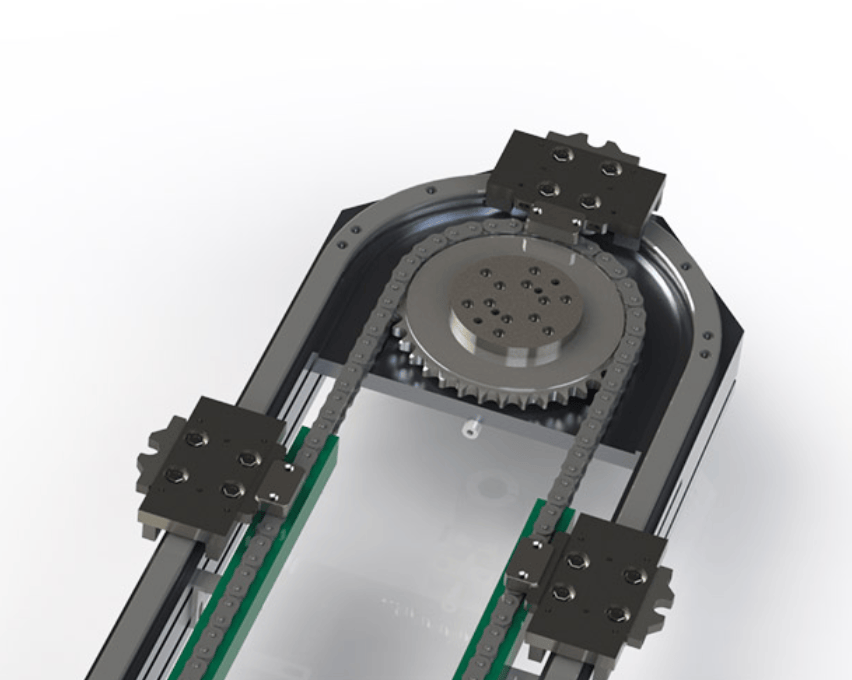I. Core structure: synergistic design of rollers and rollers
The mystery of the multiplier chain's speed increase stems from its special mechanical structure. It consists of two key components:
- Internal chain roller: Smaller diameter (usually labelled d), rolls in direct contact with the guideway, providing base travel speeds
- External Chain Roller: Larger diameter (labelled D), linked to the rollers by means of a pin, responsible for carrying the workpiece and the material.
Self-questioning: why do I need two parts with different diameters?
The small diameter of the rollers is designed to ensure that the chain runs smoothly on the guides, while the large diameter of the rollers amplifies the linear speed through leverage. This difference in size is the physical basis for the speed multiplication effect.
II. Principle of motion superposition and mathematical derivation
The nature of the multiplier chain's growth rate is a composite superposition of two movements:
- Chain overall panning: The chain is driven by a motor-driven sprocket at a constant speed of V₁.
- Roller spin effect: When the roller pushes the roller to rotate, an additional linear velocity V₂ is generated due to D>d
Velocity synthesis formula::
Vgather
= V₁ + (D/d) × V₁ = V₁ × (1 + D/d)
Example: When D=2d, the speed of the workpiece reaches 3 times the speed of the chain.
| Multiplier Type | Roller/roller diameter ratio | Theoretical growth rate effect |
|---|---|---|
| 2.5x speed chain | D=1.5d | 2.5 times faster |
| 3x Chain | D=2d | Three times faster |
III. Key influences on the effectiveness of the real growth rate
Theoretically calculated values are discounted in practical applications and are governed by three main factors:
- friction loss
The sliding friction between the roller and the guideway consumes energy, and the measured speed is usually lower than the theoretical value 8%-15%. High-precision guideway + regular lubrication can reduce the loss. - Manufacturing tolerances
Slight deviation in the diameter of rollers and rollers will lead to unstable speed increase. The diameter error of high quality chain is controlled within ±0.05mm. - Load Deflection
Engineering plastic rollers are prone to deformation under heavy loads (mitigated by steel rollers) and the diameter ratio D/d is dynamically reduced.
Self-question: why not increase the diameter of the rollers infinitely?
The roller size is limited by the chain pitch. If the rollers are too large, neighbouring rollers will interfere with each other, leading to chain jamming or even breakage. The current engineering limit is D≤3d.
IV. System synergy: from components to complete conveyor lines
The effectiveness of the Speed Chain relies on the synergy of four modules:
- transmission module
Inverter motor + reducer driven sprocket, speed range 0.5-8 m/s - Positioning module
Photoelectric sensor + pneumatic stopper for ±0.5mm stopping accuracy - carrier module
Material of work plate is selected according to the load (steel plate > engineering plastics > wood plate) - expansion module
Elevating translators/translators for diverting and combining flows and building circulatory systems
V. Technology Evolution and Industry Application Prospects
A new generation of multiplier chains is breaking through traditional limitations:
- Composite material rollers
Carbon fibre reinforced nylon rollers combine light weight and deformation resistance to increase life by 3 times. - Intelligent Speed Control System
IIoT sensors monitor loads in real time and dynamically adjust chain speeds - Modular rail design
Support straight line / S-bend / multi-layer layout rapid reconfiguration, adapt to flexible production
Personal opinion: Although the physical speed increase principle of the speed multiplier chain is simple, the engineering landing needs to balance the precision, cost and reliability. The future breakthrough lies in reducing friction loss through material science and integrating digital twin technology to realise predictive maintenance - this is more valuable to the industry than simply pursuing higher speeds.













